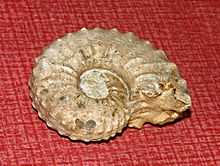Acanthoceratinae
| Acanthoceratinae Temporal range: Cretaceous, 125.45–89.3 Ma |
|
|---|---|
 |
|
| Fossil shell of Acanthoceras rhotomagensis from France, on display at Galerie de paléontologie et d'anatomie comparée in Paris | |
| Scientific classification | |
| Kingdom: | Animalia |
| Phylum: | Mollusca |
| Class: | Cephalopoda |
| Subclass: | †Ammonoidea |
| Order: | †Ammonitida |
| Family: | †Acanthoceratidae |
| Subfamily: |
†Acanthoceratinae Grossouvre, 1894 |
The Acanthoceratinae comprise a subfamily of ammonoid cephalopods that lived during the Late Cretaceous from the latter early Cenomanian to the late Turonian
Shells are evolute, tuberculate and ribbed, with subquadrate to squarish whorl section wherein tubercles typically dominate over ribs. Derivation is from the Mantellicertinae in the early Cenomanian. Gave rise through Neocardioceras to the Mammitinae.
The following genera are included in the Acanthoceratinae according to various sources as indicated.
Fossils of species within the Acanthoceratinae have been found in Upper Cretaceous sediments in Angola, Antarctica, Australia, Brazil, Canada, Denmark, Egypt, France, Germany, Japan, Jordan, Madagascar, Mexico, Nigeria, Oman, Peru, Russia, Switzerland, United Kingdom, United States and Venezuela.
...
Wikipedia
